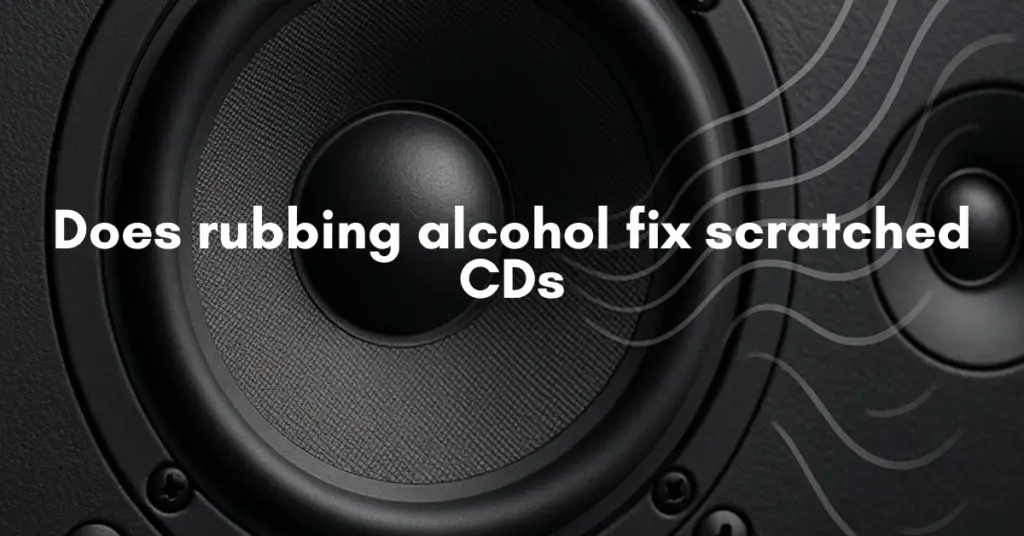Rubbing alcohol is commonly mentioned as a quick way to “fix” scratched CDs, but its actual purpose is limited. While rubbing alcohol can clean the disc and remove oils, fingerprints, and residue, it does not repair scratches. Scratches interfere with how the laser reads data, and alcohol cannot fill, smooth, or remove them. However, rubbing alcohol is still useful as part of the cleaning process when preparing a disc for polishing or resurfacing.
What Rubbing Alcohol Can Do
Rubbing alcohol (isopropyl alcohol) is effective at:
• Removing fingerprints
• Lifting dirt, dust, and grease
• Clearing sticky residue
• Eliminating surface cloudiness caused by oils
These contaminations often scatter the laser beam the same way shallow scratches do. Cleaning the disc may restore readability in cases where the “scratch” is actually just a smudge.
Alcohol works because it evaporates quickly, leaves minimal residue, and is safe for the polycarbonate layer on the bottom of the disc.
What Rubbing Alcohol Cannot Do
Rubbing alcohol cannot repair:
• Light scratches
• Deep scratches
• Gouges
• Damage to the reflective layer
• Scratches on the label side where the data layer sits
Scratches are physical imperfections in the plastic. Alcohol does nothing to alter the shape, depth, or angle of these imperfections. The only way to improve actual scratches is through abrasive polishing or resurfacing, not alcohol.
How to Use Rubbing Alcohol Safely on CDs
If using rubbing alcohol to clean a disc, follow these steps:
-
Mix isopropyl alcohol with equal parts water (50/50). Full-strength alcohol can dry too fast.
-
Apply gently with a soft microfiber cloth.
-
Wipe from the center outward, never in circles.
-
Let it air-dry or wipe with a dry, lint-free cloth.
This can help the laser read through dirt or haze, but will not smooth scratches.
Why Scratches Require Abrasive Repair
Scratches scatter the laser beam so it cannot properly follow the data spiral. To fix this, you must:
• Sand/polish the plastic lightly to reduce scratch depth
• Re-level the surface
• Remove small imperfections that deflect the laser
Toothpaste (mild abrasive), plastic polish, or a resurfacing machine works by removing a thin layer of plastic, revealing a smoother surface beneath. Alcohol alone lacks any abrasive action.
When Alcohol Seems to “Fix” Scratches
Sometimes people believe alcohol “fixed” the disc because:
• The disc was dirty, not scratched
• The cleaning reduced haze that looked like scratches
• The laser could read again after smudge removal
In these cases, alcohol helped because contamination—not actual scratching—was the problem.
Situations When Alcohol Should Not Be Used
Avoid rubbing alcohol if:
• The disc has label-side damage
• The disc uses cheap dyes (some CD-Rs are sensitive)
• You are unsure of the cloth type (abrasive fabrics can worsen scratches)
Never use acetone, nail polish remover, or strong solvents. These can melt polycarbonate instantly.
What Actually Repairs Scratched CDs
If rubbing alcohol doesn’t help, try:
• Commercial disc polish (e.g., Novus 2)
• Toothpaste (non-gel, mild abrasive only)
• A disc repair machine
• Professional resurfacing services
These methods physically smooth scratches and restore readability far more effectively than alcohol.
Rubbing alcohol does not fix scratched CDs. It cannot alter scratches or repair damaged plastic. What it can do is clean the disc by removing fingerprints, dust, and oil that might mimic or worsen reading problems. For true scratch removal, polishing or resurfacing is required. Alcohol is a helpful cleaning step—but not a scratch repair solution.

